There’s a science to writing sales emails: What the data REALLY says

So you want to write better sales emails?
Close more deals?
Grow your career in sales (and top the leaderboard)?
If that doesn’t describe you, maybe you should not be in sales?
But if it sounds aligned with your goals, keep reading.
The most successful salespeople send the best emails.
They know that email is not dead. They understand the power of an attention-grabbing subject line, a suck-you-in opening sentence, an OMG-I-have-to-click CTA.
But how do you actually write that sales email that gets opened, read, and clicked? How do you use email to not only open the conversation but keep it moving through the sales funnel to closed/won?
The answer, as you may have suspected, will be detailed below.
But before we share the how, let’s review the why.
Why writing GREAT sales emails is super important.
First, every form of communication and every type of interaction — text, email, in-person, phone, video call, and so on — is a reflection of who you are as a company.
Whether consciously or not, your customers and prospects are constantly asking themselves, “Is this a company I’d want to do business with? Is this an organization I’d be proud to be associated with?
How you communicate matters.
Email is no exception. You could argue email is one of the most essential forms of communication because of (a) how easy it is to fire off 1 (or one million) emails and (b) how often salespeople use email to interact with customers and prospects.
Second, sales emails are necessary and vital for every stage of the sales cycle: prospecting, follow-ups, multi-threading, negotiating, closing … all of it!
And third, of all the channels mentioned above, email is the one that builds momentum in your deals, specifically email velocity … the number of emails exchanged between buyers and sellers.
More emails = more deals.

And let’s be clear about email velocity. It is not the number of emails YOU send, but the number of emails exchanged between YOU and the BUYER.
Note: Be aware that as you go further into the sales cycle, the number of weekly sales emails exchanged will bump from ~8 emails to ~11.5.
We’d love for you to keep reading, but while you are here, check out our 11 highly-persuasive sales email templates.
A bit more about this Gong data
See that “More Email = More Deals” chart above? Well, that’s not just a fancy, made-up Gong-ified image. Nope. It’s based on data.
Here’s a quick explanation of how we get our data.
The Gong sales engagement platform takes in hundreds thousands millions of anonymized customer data points — from web conference meetings, phone calls, and emails – and uses our AI tool to analyze how seller and buyer actions and behavior impacts success* rates.
*Success = moving a deal from cold call to booked meeting, from meeting to negotiation, from proposal & pricing conversation to closed/won … and everything in between.
Here’s what it looks like:

Each data point tells a story.
For this particular article, we looked at all the data related to how to write a sales email.
Here is what the data told us.
Want more sales email statistics? Here ya go.
Avoid ROI language in cold emails.
ROI. Return on Investment. Ensuring the value of the product or service you bought is equal to (or ideally, more) than what you paid for it.
ROI is one of those “bragging” stats. “Look how we helped Company ABC. We did it for them … and we can do it for YOU too!”
ROI is 100% something you should mention during part of the sales process … just not during the cold call stage.
And that’s not just me telling you what I think works (or doesn’t work). It’s based on data, of course. In fact, to come up with this conclusion, we reviewed over 132,000 emails to understand how “ROI language” impacted cold email success rates.
ROI language included words or phrases in the salesperson’s email — literally “ROI” or any stats that are tied to ROI like multipliers (2x, 10x, and so on.) and percentages (7%, 42%, etc.)
And the data say … using ROI language in cold emails decreases success rates by 15%.
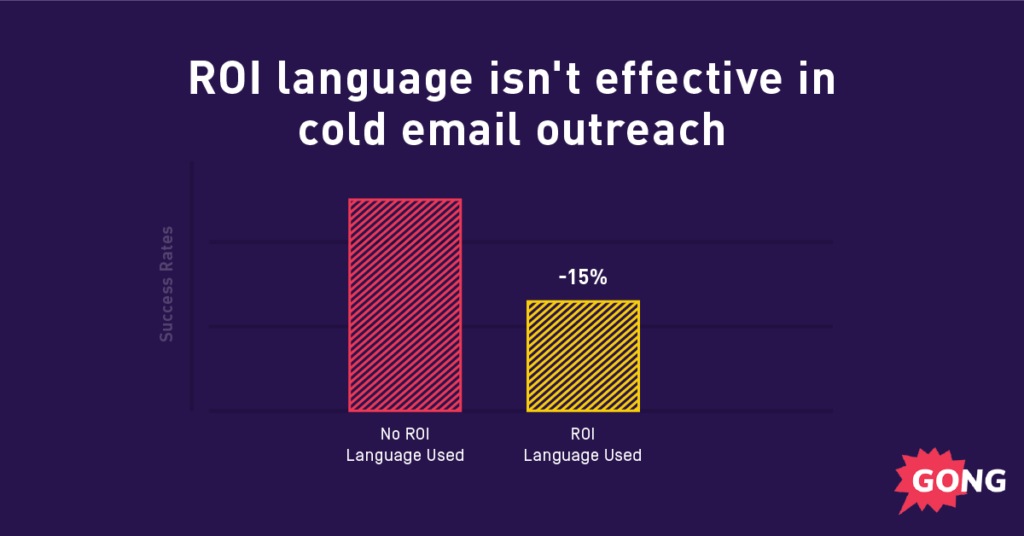
15% is no joke. That percentage can easily make or break your ability to reach your sales goals.
ROI doesn’t play in the first sales email because it is just a number — a number lacking context, not connected to the prospect’s pain, to their reality.
The last thing you want your buyer to think when reading your email is, “So what? Who cares? How does this impact me or my job?”
Finally, remember: Buyers make decisions based on emotions, then justify their decision with logic (ROI is logic).
Write longer cold emails.
What if I told you longer cold emails could result in a 15x increase in your odds to book a meeting?
No brainer, right?
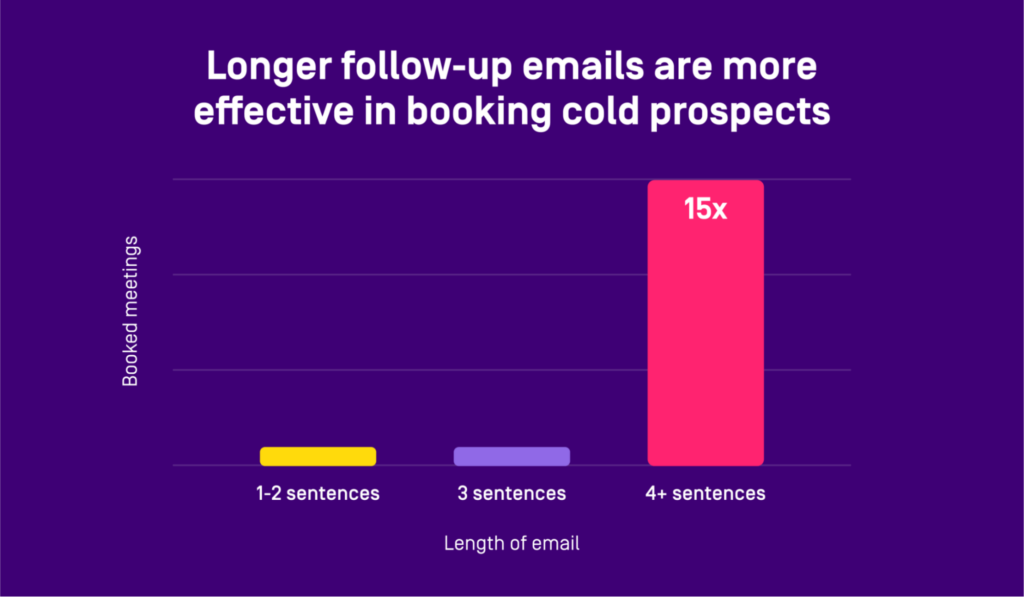
Longer emails are significantly (15x) more effective in booking a meeting during cold call outreach.
Remember: short and concise are not necessarily the same.
Short is generally 30 words or less. Concise usually means short, but it also implies meaning and context. Longer sales emails (4+ sentences) are effective if concise and offer value to the recipient.
Be sure your (longer) emails — every single world — are intentional and have specific information that connects your reader to your company or service.
And THAT is how to write a sales email.
Not sure where to start? Staring at the blank page?
Check out these 5 sales email examples that hit the right notes (and closed the deal).
Ask for interest (not time)
It took us 304,174 emails to learn this one:
You are 2x+ more likely to book a meeting during a cold email when asking your prospect for their interest versus asking for time (a specific or open-ended CTA).
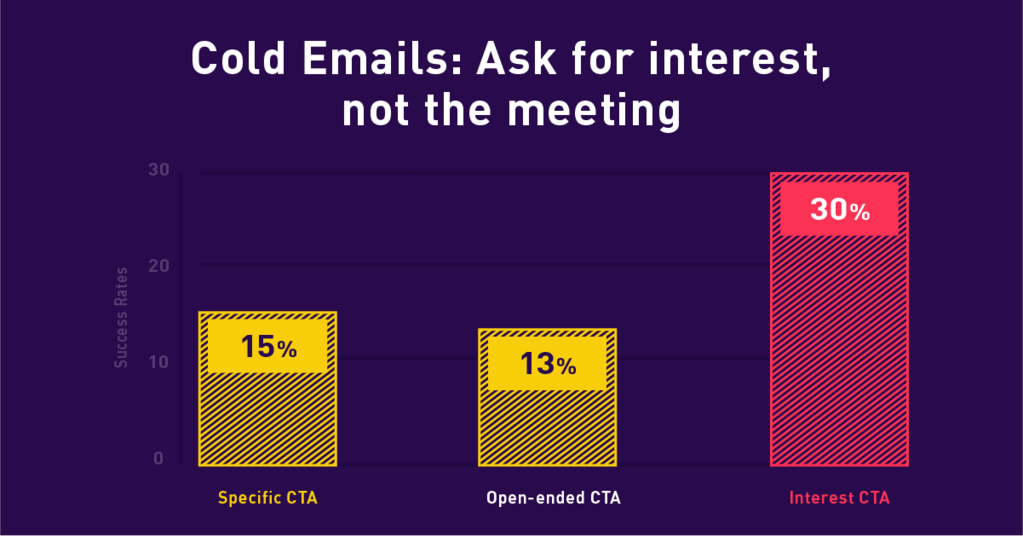
To pull this number, we looked at the CTA language in those 300k+ emails. “Success” meant a meeting booked within 10 days. Some version of “Please remove me from your email list” did not count.
Before we talk more about the interest CTA, let’s review the other two CTAs:
- A specific CTA is, “Can you meet tomorrow at 3 PM PT?”
- An open-ended CTA is, “Are you available to meet sometime later this week?”
An interest CTA is, “Are you interested in learning more about X?”
You are not asking for the buyer’s time, just their interest. An interest CTA sells the conversation, not the meeting.
And that matters because time is finite — 24/7/365, you know. So why would a buyer give YOU, a seller who they know little about, some of that super-valuable time?
Contrast that with interest — a “non-finite resource,” and you are more likely to move your deal forward.
Psssst… These cold email templates lose all the low-performing “best practices” and replace it with high-open, high-reply cold email techniques. Download them for free:
For deal emails, use specific CTAs.
However, an interest email is not the end-all-be-all solution at every stage of the sales cycle.
As you move a buyer down the funnel — towards a deal — it’s time to leverage the specific CTA.
Why? Well, asking for a specific day and time during a deal email more than doubles meetings booked, from 15% in the cold email stage to 37% in the deal stage.
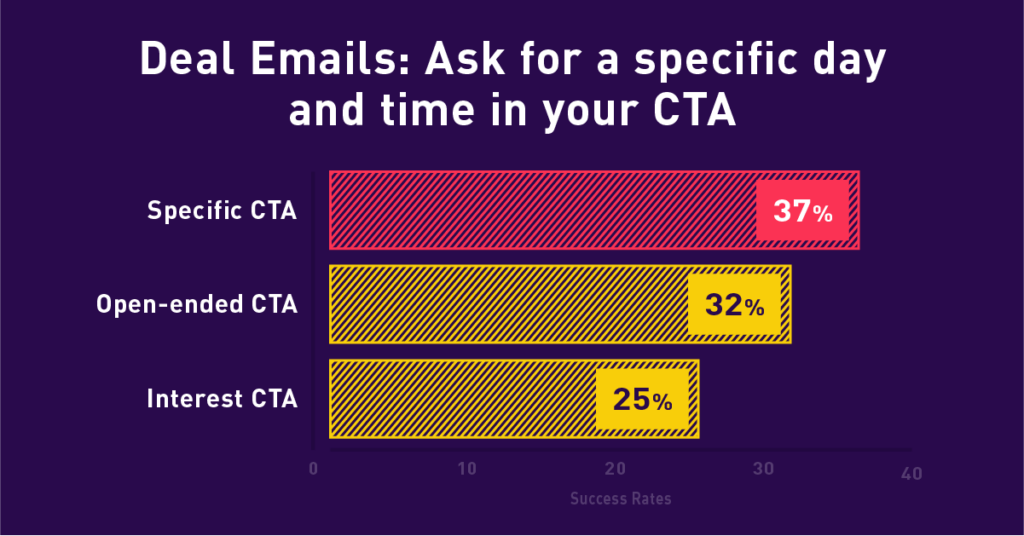
Yup.
At this point, you already have your buyer’s interest. Done. They took that first meeting, moving past the cold outreach. Now get right to it. Be direct. Remove friction. Help your buyer through the journey!
Share price by email
Share price over email? Wait. Is that a typo? You meant, DO NOT share price over email.
Wrong. No typo. We meant what we wrote!
You may have assumed sharing price by email is the wrong approach, but you’d be assuming incorrectly.
And you know how we feel about assumptions here at Gong (we err on the side of reality).
Discussing price over email has a significant POSITIVE impact on win rates:
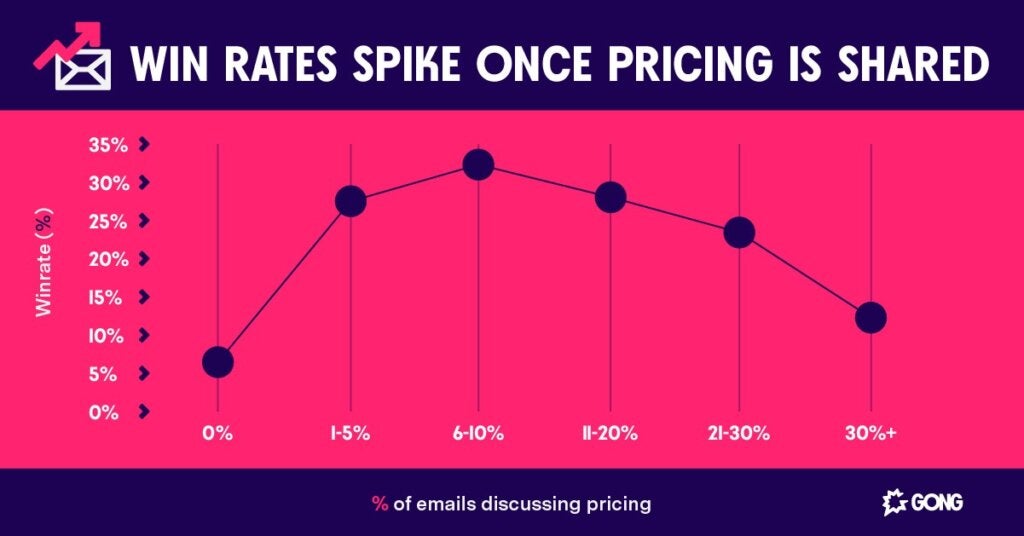
Right?
Also, sharing pricing early in the sales cycle is best. If pricing is way off, it can be a colossal waste of time for both the buyer and YOU, the seller.
In sales (and life), time = money.
Do NOT negotiate price via email.
Ahhh … negotiation.
“The secret to gaining the upper hand in a negotiation is to give the other side the illusion of control. Don’t try to force your opponent to admit that you are right. Instead, ask questions that begin with ‘How?’ or ‘What?’ so your opponent uses mental energy to figure out the answer.”
Sound advice from master negotiator Chris Voss. However, we should add one more thing to the “ask questions” part. “Ask questions that being with ‘How?’ or ‘What?’ But do NOT ask those questions in an email!”
Once you begin to negotiate price over email, your win rates start to drop.
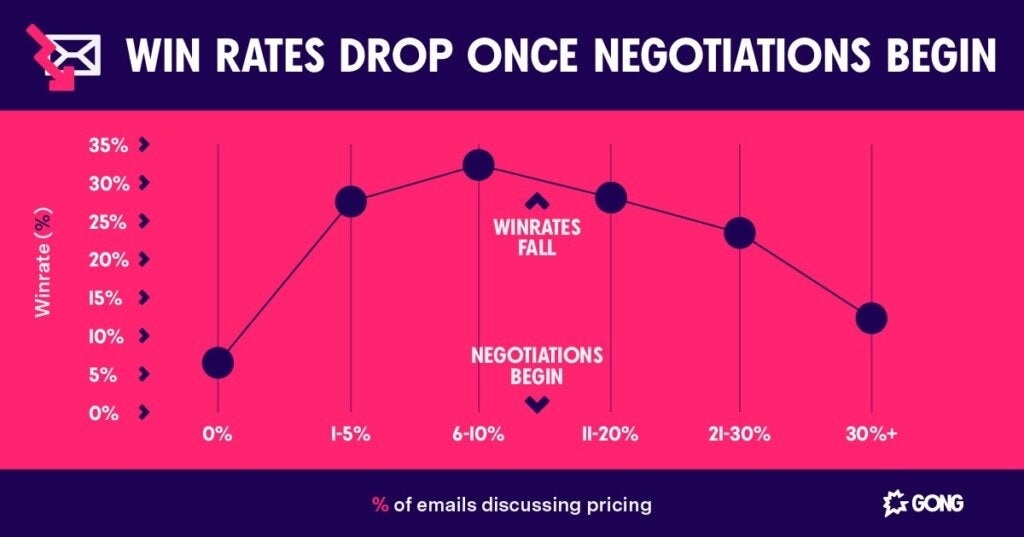
The problem is that email is essentially a one-way conversation. You email something, your buyer emails back. Email … pause … email. And so on.
Sales emails, like other forms of one-way communication, often suffer from assumptions and misinterpretations. On top of that, email provides your buyer an upper hand: TIME.
Here’s what we (and the data) suggest instead: When negotiating price, go back and forth between two channels — email and phone. For example:
- Email price; negotiate by phone
- Negotiate by phone; confirm price via email
The data:

The data tells the story again.
BONUS: More sales skills here.
Now you know …
… what Gong knows — based on data — about how to write a sales email.
To recap:
- Avoid ROI-language in cold emails
- Write longer cold emails
- Ask for interest (not for time)
- For deal emails, use specific CTAs instead
- Share price by email…
- … but don’t negotiate
And we’ve made it veeerrrrry easy for you to take advantage of these data-driven suggestions today. Download our 11 fill-in-the-blanks, highly-persuasive sales email templates and start closing more deals immediately.
Now go sell!

